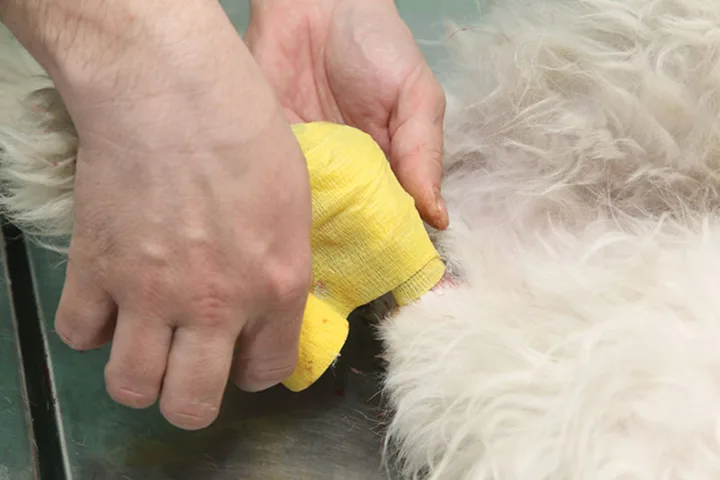Antibiotics in Surgical Patients

You have asked…When should antibiotics be used to prevent surgical site infection (SSI)?
Antibiotic use in surgical patients is aimed at preventing SSIs or treating known preexisting infections. In the latter case, antibiotic administration should follow general principles of appropriate antimicrobial therapy, which are beyond the scope of this article.1
Antibiotic use is not innocuous, despite minimal adverse effects.
Antibiotic use is not innocuous, despite minimal adverse effects. Inappropriate antibiotic use can result in a high risk for therapeutic failure and emerging bacterial resistance, affecting both the patient and its environment. Because bacterial resistance is a major public health concern, veterinary professionals need to demonstrate responsibility and dedication to avoid antibiotic misuse or face limitations and loss of privilege in prescribing these drugs. It is, therefore, each veterinarian’s duty to critically review antibiotic use according to the best available evidence.
Antibiotics & SSI Risks
The preliminary step in judicious antibiotic administration is to understand what can be expected from their use. SSI development depends on several factors: the amount and nature (virulence) of bacterial contamination, local conditions (wound), and susceptibility of the host (patient). Thus, prevention of SSI must be seen as a chain of factors, including patient condition, surgical preparation, antimicrobial administration strategy, potential for contamination in the surgical environment, and wound condition (depends on the quality of surgical technique). The strength of this chain is limited by its weakest link. Increasing the antibiotics administered (ie, type, dose, duration) to patients involved in excessively traumatic surgical procedures or when poor aseptic technique has been used will not necessarily lower the SSI rates but can favor bacterial resistance and clinical adverse effects. Similarly, using antibiotics locally within the peritoneal and thoracic cavities is not recommended, as these agents induce local inflammation and have not proven beneficial.2,3 Perioperative antibiotics are an adjunct to (ie, not a substitute for) proper surgical preparation and technique. Advanced surgical experience (implying lesser surgical trauma), may confound the potential effect of antimicrobial prophylaxis.2,3 Unfortunately, antibiotics are often prescribed to compensate for insufficient surgical preparation or intraoperative care.
Every effort should be made to strengthen all links of the chain equally. The surgeon must strictly adhere to the rules of asepsis and strive to minimize surgical trauma while implementing a sensible approach to antibiotic use.
Antimicrobial Prophylaxis & Therapy
Antimicrobial prophylaxis refers to the use of antibiotics to prevent an expected infection caused by contamination. For prophylaxis, appropriate antibiotic concentrations must be present in exposed tissues at contamination and for a few hours after, but not before or beyond contamination. Given the pharmacokinetics of most antibiotics, this means that they are best given intravenously within an hour before skin incision and repeated as necessary to maintain sufficient antibiotic levels in the tissues throughout the procedure and for a few hours following it. Studies have shown that administration of antibiotics after contamination (eg, after surgery) is ineffective and may even increase the risk for SSI.4,5

Antimicrobial prophylaxis refers to prevention of an expected infection caused by contamination.
Typically, antibiotics are given at anesthetic induction (ie, ~30 minutes before incision) and readministered q90min during the procedure. When the surgery ends slightly before scheduled readministration, antibiotics should be administered as if the surgery was not finished. If orthopedic implants are used, prolonging the series of administration for a few hours (≤24) after surgery is sometimes recommended. In case of massive fluid replacement for blood loss (≥20–25 mL/kg), antibiotic tissue concentrations are decreased and surgeons must consider one additional antibiotic administration after fluid replacement.6 In prophylaxis, as no infection is present, the antibiotic must target the pathogens most likely to contaminate the wound.
Antimicrobial therapy, meanwhile, refers to the treatment of an existing infection and consists of administering antibiotics targeted at the main infectious pathogens, until the infection is reduced enough to be eliminated by the host’s defenses. Typically, antibiotics are given before, during, and for several days after surgery. For patients already on antibiotics, the necessity and timing of perioperative antibiotic administration must be determined on an individual basis: the sensitivity of expected pathogens to the antibiotic and its pharmacokinetics should be considered to ensure that effective concentrations are present in tissues before potential contamination.
Antimicrobial therapy refers to treatment of an existing infection.
Current Recommendations
Antibiotics do not only affect pathogens. Broad-spectrum antibiotics can alter normal microbial flora in unpredictable ways, possibly promoting bacterial resistance in some of its components.7 To limit this adverse effect, narrow-spectrum (vs wide-spectrum) antibiotics are preferred when possible to limit resistance or development of resistance.7 Only first-generation, narrow-spectrum antibiotics active against the main SSI pathogens in small animals (eg, Staphylococcus spp, Escherichia coli, Pasteurella spp) should be used, particularly for prophylaxis. Newer, broad-spectrum antibiotics (eg, fluoroquinolones) should be avoided for prophylaxis to reduce the emergence of resistant bacterial strains.8
Intraoperative wound contamination cannot be avoided. Two studies found that suction tips were contaminated in 44% and 68% of small animal surgeries performed under strict aseptic technique.9,10 Contamination may originate from the patient (eg, skin, nonsterile hollow organs) or the environment (eg, room air, surgical team). Contamination can increase with surgery duration but can be minimized by strict adherence to principles of surgical asepsis. In this context, antibiotics can eliminate enough bacteria reaching the wound to decrease immediate postoperative contamination to numbers the host defenses can eradicate (ie, below 4.102–105 microbes/gram of tissues). However, the presence of foreign bodies (eg, orthopedic implants), high degree of wound tissue trauma, or a generally debilitated patient can reduce the contamination required for SSI to develop.
When deciding whether to give antibiotics to a surgical patient, the status of its general condition (American Society of Anesthesiologists [ASA], see ASA Status), wound class (see Wound Classification), and other factors increasing the risk for SSI (eg, placement of implants, duration of surgery) should be considered. The benefits of antibiotic prophylaxis are proportional to the severity of the consequences of a potential SSI. Therefore, for most surgeries, it does not alter long-term prognosis but decreases short-term morbidity.6 Conversely, when infection would have devastating consequences (eg, brain surgery), antibiotic prophylaxis is commonly recommended, regardless of the previous considerations.
For short, clean or clean-contaminated surgeries in which no implants are placed and in low ASA-risk patients (I–II, some III), antibiotic administration is unnecessary. For clean or clean-contaminated surgeries that last longer (typically >60–90 minutes), where significant tissue trauma is expected or implants are used or already present (eg, orthopedic implants, meshes), antimicrobial prophylaxis is recommended. It is also recommended in patients with concurrent disease that may impair immune defenses (eg, significant endocrinopathies) or patients with high ASA status (IV–V, some III) because of nonseptic diseases. For contaminated surgeries, antibiotic prophylaxis is recommended. Depending on the contamination and extent to which it has been contained and eliminated during surgery, antimicrobial therapy may also be indicated. For dirty surgeries infection is present at the time of surgery and antimicrobial therapy is also indicated.
The antibiotic administered must be safe, effective against expected pathogens, and able to reach appropriate concentrations in contaminated tissues. In most surgical patients, cefazolin, a first-generation cephalosporin, fulfills these criteria and is appropriate for antimicrobial prophylaxis. When the expected pathogens include anaerobes (eg, during hepatic and colorectal surgeries), cefoxitin (second-generation cephalosporin) or cefotetan is preferred. Alternatively, metronidazole can be added to a first-generation cephalosporin for anaerobic coverage (Table).
SSI = surgical site infection, ASA = American Society of Anesthesiologists
This article is part of the WSAVA Global Edition of Clinician's Brief.
Laurent Findji, DMV, MS, MRCVS, DECVS, is soft-tissue surgeon and director at VRCC Veterinary Referrals near London, England. His interests include oncologic, reconstructive, and general soft tissue surgeries. Before his 3 years in private practice and 4 years as consulting surgeon, Dr. Findji was a teaching assistant and completed a 2-year surgical internship at National Veterinary School of Alfort in Paris, France, where he earned his DMV. He earned his MS in biology and physiology of circulation and respiration at La Pitié-Salpêtrière Hospital in Paris, France, and a degree in experimental surgery and microsurgery at the Lariboisère St. Louis Hospital in Paris, France.